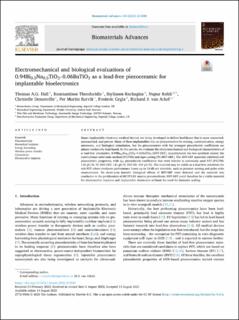| dc.contributor.author | Hall, Thomas A.G. | |
| dc.contributor.author | Theodoridis, Konstantinos | |
| dc.contributor.author | Kechagias, Stylianos | |
| dc.contributor.author | Kohli, Nupur | |
| dc.contributor.author | Denonville, Christelle | |
| dc.contributor.author | Rørvik, Per Martin | |
| dc.contributor.author | Cegla, Frederic | |
| dc.contributor.author | van Arkel, Richard J. | |
| dc.date.accessioned | 2024-02-09T08:29:29Z | |
| dc.date.available | 2024-02-09T08:29:29Z | |
| dc.date.created | 2023-08-22T08:48:12Z | |
| dc.date.issued | 2023 | |
| dc.identifier.citation | Biomaterials Advances. 2023, 154: 213590. | en_US |
| dc.identifier.issn | 2772-9516 | |
| dc.identifier.uri | https://hdl.handle.net/11250/3116513 | |
| dc.description.abstract | Smart implantable electronic medical devices are being developed to deliver healthcare that is more connected, personalised, and precise. Many of these implantables rely on piezoceramics for sensing, communication, energy autonomy, and biological stimulation, but the piezoceramics with the strongest piezoelectric coefficients are almost exclusively lead-based. In this article, we evaluate the electromechanical and biological characteristics of a lead-free alternative, 0.94Bi0.5Na0.5TiO3–0.06BaTiO3 (BNT-6BT), manufactured via two synthesis routes: the conventional solid-state method (PIC700) and tape casting (TC-BNT-6BT). The BNT-6BT materials exhibited soft piezoelectric properties, with piezoelectric coefficients that were inferior to commonly used PZT (PIC700: 116 pC/N; TC-BNT-6BT: 121 pC/N; PZT-5A: 400 pC/N). The material may be viable as a lead-free substitute for soft PZT where moderate performance losses up to 10 dB are tolerable, such as pressure sensing and pulse-echo measurement. No short-term harmful biological effects of BNT-6BT were detected and the material was conducive to the proliferation of MC3T3-E1 murine preosteoblasts. BNT-6BT could therefore be a viable material for electroactive implants and implantable electronics without the need for hermetic sealing. | en_US |
| dc.language.iso | eng | en_US |
| dc.publisher | Elsevier | en_US |
| dc.rights | Navngivelse 4.0 Internasjonal | * |
| dc.rights.uri | http://creativecommons.org/licenses/by/4.0/deed.no | * |
| dc.title | Electromechanical and biological evaluations of 0.94Bi0.5Na0.5TiO3–0.06BaTiO3 as a lead-free piezoceramic for implantable bioelectronics | en_US |
| dc.title.alternative | Electromechanical and biological evaluations of 0.94Bi0.5Na0.5TiO3–0.06BaTiO3 as a lead-free piezoceramic for implantable bioelectronics | en_US |
| dc.type | Journal article | en_US |
| dc.description.version | publishedVersion | en_US |
| dc.rights.holder | © 2023 The Authors. Published by Elsevier. | en_US |
| dc.source.pagenumber | 11 | en_US |
| dc.source.volume | 154 | en_US |
| dc.source.journal | Biomaterials Advances | en_US |
| dc.identifier.doi | 10.1016/j.bioadv.2023.213590 | |
| dc.identifier.cristin | 2168601 | |
| dc.relation.project | Norges forskningsråd: 297561 | en_US |
| dc.source.articlenumber | 213590 | en_US |
| cristin.ispublished | true | |
| cristin.fulltext | original | |
| cristin.qualitycode | 1 | |

